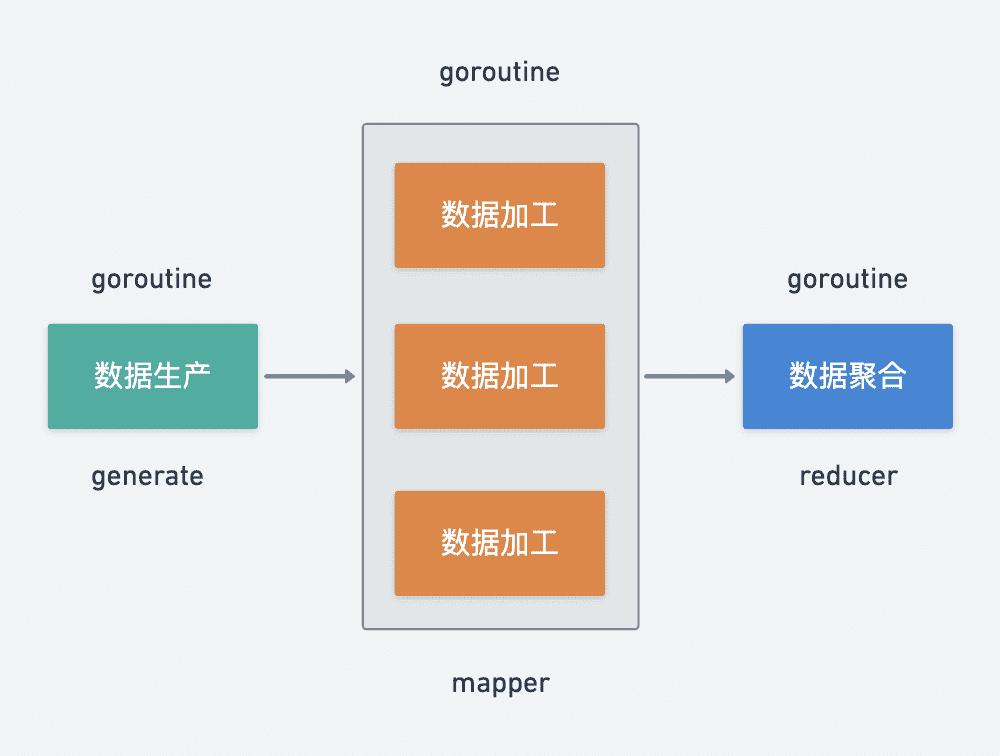https://github.com/kevwan/mapreduce
A in-process MapReduce library to help you optimizing service response time or concurrent task processing.
https://github.com/kevwan/mapreduce
concurrent concurrent-programming go golang mapreduce mapreduce-go
Last synced: 5 months ago
JSON representation
A in-process MapReduce library to help you optimizing service response time or concurrent task processing.
- Host: GitHub
- URL: https://github.com/kevwan/mapreduce
- Owner: kevwan
- License: mit
- Created: 2021-12-31T10:03:06.000Z (almost 4 years ago)
- Default Branch: main
- Last Pushed: 2024-07-02T01:48:28.000Z (over 1 year ago)
- Last Synced: 2025-07-04T16:14:40.245Z (5 months ago)
- Topics: concurrent, concurrent-programming, go, golang, mapreduce, mapreduce-go
- Language: Go
- Homepage: https://go-zero.dev
- Size: 44.9 KB
- Stars: 174
- Watchers: 3
- Forks: 24
- Open Issues: 2
-
Metadata Files:
- Readme: readme-cn.md
- License: LICENSE
Awesome Lists containing this project
README
# mapreduce
[English](readme.md) | 简体中文
[](https://github.com/kevwan/mapreduce/actions)
[](https://codecov.io/gh/kevwan/mapreduce)
[](https://goreportcard.com/report/github.com/kevwan/mapreduce)
[](https://github.com/kevwan/mapreduce)
[](https://opensource.org/licenses/MIT)
## 为什么会有这个项目
`mapreduce` 其实是 [go-zero](https://github.com/zeromicro/go-zero) 的一部分,但是一些用户问我是不是可以单独使用 `mapreduce` 而不用引入 `go-zero` 的依赖,所以我考虑再三,还是单独提供一个吧。但是,我强烈推荐你使用 `go-zero`,因为 `go-zero` 真的提供了很多很好的功能。
## 为什么需要 MapReduce
在实际的业务场景中我们常常需要从不同的 rpc 服务中获取相应属性来组装成复杂对象。
比如要查询商品详情:
1. 商品服务-查询商品属性
2. 库存服务-查询库存属性
3. 价格服务-查询价格属性
4. 营销服务-查询营销属性
如果是串行调用的话响应时间会随着 rpc 调用次数呈线性增长,所以我们要优化性能一般会将串行改并行。
简单的场景下使用 waitGroup 也能够满足需求,但是如果我们需要对 rpc 调用返回的数据进行校验、数据加工转换、数据汇总呢?继续使用 waitGroup 就有点力不从心了,go 的官方库中并没有这种工具(java 中提供了 CompleteFuture),go-zero 作者依据 mapReduce 架构思想实现了进程内的数据批处理 mapReduce 并发工具类。
## 设计思路
我们尝试梳理一下并发工具可能的示例业务场景:
1. 查询商品详情:支持并发调用多个服务来组合产品属性,支持调用错误可以立即结束。
2. 商品详情页自动推荐用户卡券:支持并发校验卡券,校验失败自动剔除,返回全部卡券。
以上实际都是在进行对输入数据进行处理最后输出清洗后的数据,针对数据处理有个非常经典的异步模式:生产者消费者模式。于是我们可以抽象一下数据批处理的生命周期,大致可以分为三个阶段:

1. 数据生产 generate
2. 数据加工 mapper
3. 数据聚合 reducer
其中数据生产是不可或缺的阶段,数据加工、数据聚合是可选阶段,数据生产与加工支持并发调用,数据聚合基本属于纯内存操作单协程即可。
再来思考一下不同阶段之间数据应该如何流转,既然不同阶段的数据处理都是由不同 goroutine 执行的,那么很自然的可以考虑采用 channel 来实现 goroutine 之间的通信。

如何实现随时终止流程呢?
`goroutine` 中监听一个全局的结束 `channel` 和调用方提供的 `ctx` 就行。
## 版本选择
- `v1`(默认)- 非泛型版本
- `v2`(泛型版)- 泛型版本,需要 Go 版本 >= 1.18
## 简单示例
并行求平方和(不要嫌弃示例简单,只是模拟并发)
```go
package main
import (
"fmt"
"log"
"github.com/kevwan/mapreduce/v2"
)
func main() {
val, err := mapreduce.MapReduce(func(source chan<- int) {
// generator
for i := 0; i < 10; i++ {
source <- i
}
}, func(i int, writer mapreduce.Writer[int], cancel func(error)) {
// mapper
writer.Write(i * i)
}, func(pipe <-chan int, writer mapreduce.Writer[int], cancel func(error)) {
// reducer
var sum int
for i := range pipe {
sum += i
}
writer.Write(sum)
})
if err != nil {
log.Fatal(err)
}
fmt.Println("result:", val)
}
```
更多示例:[https://github.com/zeromicro/zero-examples/tree/main/mapreduce](https://github.com/zeromicro/zero-examples/tree/main/mapreduce)
## 强烈推荐!
go-zero: [https://github.com/zeromicro/go-zero](https://github.com/zeromicro/go-zero)
## 欢迎 star!⭐
如果你正在使用或者觉得这个项目对你有帮助,请 **star** 支持,感谢!